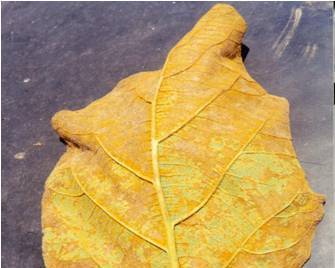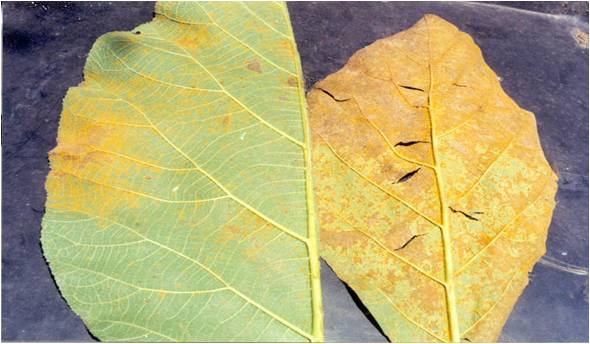This is an important disease in nurseries and young plantations of economically important tree species.
The disease appears in the nursery after the regular monsoon rains and due to improper maintenance of nursery stock.
Some of the important forestry species such as Albizia lebbeck, Dalbergia sissoo, Pongamia pinnata, Poplar, Tectona grandis, Terminalia chebula, etc are affected by this disease.
This disease is caused by Ravenalia clemensiae on Albizia lebbeck. The rust fungus, Ravenelia hobsoni infects the
leaves and produces numerous chest-nut brown teliospore heads on the lower
surface of the leaves of Pongamia
pinnata.
Another rust fungus, R. stictica is also known to attack
the leaves of Pongamia pinnata. Olivea tectonae causes leaf rust disease on Teak. Maravalia
achroa causes leaf rust
disease on Dalbergia sissoo. Uredo terminaliae causes leaf rust disease on clonal plants of Terminalia
chebula.
1. Disease occurs during October to February in nurseries where Teak plants are raised and maintained. Infected leaves are almost plastered with yellowish brown fruit bodies of the fungus. The upper leaf surface presents a grey appearance due to the formation of fleeks, which correspond to the position of position of fungal spore structure on the lower surface. Infected leaves fall off prematurely resulting in retardation of plant growth.
2. In case of Dalbegia sissoo, the disease appears during February-March on leaves and juvenile twigs and continues attacking the foliage and young twigs up to July-August. The infection declines following monsoon rains. The affected parts are killed resulting in die-back and subsequent death of affected seedlings. Uredinial position of fungal spore structure are yellowish and formed on the lower surface of the leaves. Telia are colorless and pulvinate. The infected leaves are often deformed and the infected plants show perceptible retardation in growth and look stunted and weak. The disease incidence has been recorded as high as 100% in the nursery at Dehra Dun.
3.In case of Terminalia chebula, the disease (less than 25%) starts appearing during the month of November. Very severe infection (95%) may be noticed during January. Infected leaves are plastered with light brown to yellowish brown fruit bodies of the pathogen at the lower surface of the leaves. The corresponding upper surface shows grayish brown appearance. Severely infected plants show premature defoliation.
The disease can be managed by an integrated approach involving measures such as sanitation, cultural practices and use of fungicides. The disease may be effectively controlled by foliar application of 0.08% Bayleton at fortnightly intervals in case of rust disease on Dalbergia sissoo. At the initial stage of the infection, the affected portions of the leaves may be slightly trimmed off and disposed off outside the nursery. Application with sulphur based fungicide (Sulfax @ 0.05% a.i.) as foliar spray and soil drenching at fortnightly intervals are found very effective in controlling the disease. After 30 days of fungicidal application, the seedlings need to be applied with bio-control agents such as Pseudomonas fluorescence and Trichoderma viride for effective management of the disease.
Leaf Rust Disease attack on teak

Leaf Rust Disease attack on teak




